Flexural Performance of Steel–Normal Concrete–Ultra-High-Performance Concrete Composite Slabs with Steel Ribs
Abstract
:1. Introduction
2. Experimental Program
2.1. Specimen Design
2.2. Materials
2.3. Specimen Production
2.4. Loading and Testing Methods
3. Numerical Modelling
3.1. Materials
3.1.1. Concrete and UHPC
3.1.2. Steel Reinforcements and Steel Plate
3.2. Element Selection
3.3. Interface and Boundary
3.4. Construction Methods
4. Results and Analysis
4.1. Load–Deflection Curves
4.2. Cracking Pattern
4.3. Strain History
5. Theoretical Analysis
5.1. Cracking Resistance and Bearing Capacity
- (1)
- The initial cracking of concrete
- (2)
- The initial cracking of UHPC
- (3)
- The ultimate state
5.2. Verification and Comparison
6. Conclusions
- (1)
- The use of UHPC enhances the flexural performance of composite slabs, such as the cracking force and bearing capacity. Based on experiments and finite element analysis, a 5 mm UHPC layer made the bearing capacity of steel concrete composite slabs increase by 13.51%. The cracking forces of concrete and UHPC layers are clearly enhanced.
- (2)
- UHPC delays the development of cracks in the concrete and strengthens the tensile contribution of the concrete. For steel–normal concrete–UHPC composite slabs, the cracking force of concrete increases from 44 kN to 91 kN compared with steel–concrete composite slabs, which indicates an evident rise.
- (3)
- Construction methods have an evident influence on the initial cracking forces of concrete and UHPC layers. The scaffolding construction method reduces the initial cracking force of concrete from 91 kN to 69 kN compared with that of construction without brackets. For the UHPC layer, the impacts of construction methods on the initial cracking force are similar.
- (4)
- The analytical model proposed in this paper can potentially be used to calculate the cracking force and bearing capacity of steel–normal concrete–UHPC composite slabs. The results of the theoretical model considering the tensile contribution of cracking UHPC are closer to experimental values. The theoretical values are lower than the experimental values, which makes the composite slab safer in service. The theoretical cracking force of the UHPC layer is relatively higher than the experimental values, which may be attributed to material defects and a slight interface slip in the tests.
- (5)
- The durability of a steel–normal concrete–UHPC composite slab is critical for its application. Thus, the durability of a steel–normal concrete–UHPC composite slab should be studied with more experiments in the future.
Author Contributions
Funding
Data Availability Statement
Conflicts of Interest
References
- Viest, I.M. Review of research on composite steel–concrete beams. J. Struct. Div. 1960, 86, 1101–1121. [Google Scholar] [CrossRef]
- Nie, J.; Wang, J.; Gou, S.; Zhu, Y.; Fan, J. Technological development and engineering applications of novel steel-concrete composite structures. Front. Struct. Civ. Eng. 2019, 13, 1–14. [Google Scholar] [CrossRef]
- Amran, M.; Huang, S.S.; Onaizi, A.M.; Makul, N.; Abdelgader, H.S.; Ozbakkaloglu, T. Recent trends in ultra-high performance concrete (UHPC): Current status, challenges, and future prospects. Constr. Build. Mater. 2022, 352, 129029. [Google Scholar] [CrossRef]
- Shafieifar, M.; Farzad, M.; Azizinamini, A. Experimental and numerical study on mechanical properties of Ultra High Performance Concrete (UHPC). Constr. Build. Mater. 2017, 156, 402–411. [Google Scholar] [CrossRef]
- Zhou, M.; Lu, W.; Song, J.; Lee, G.C. Application of ultra-high performance concrete in bridge engineering. Constr. Build. Mater. 2018, 186, 1256–1267. [Google Scholar] [CrossRef]
- Brühwiler, E.; Denarié, E. Rehabilitation and strengthening of concrete structures using ultra-high performance fibre reinforced concrete. Struct. Eng. Int. 2013, 23, 450–457. [Google Scholar] [CrossRef]
- Rokugo, K. Recommendations for Design and Construction of High Performance Fiber Reinforced Cement Composites with Multiple Fine Cracks (HPFRCC); Japan Society of Civil Engineers, Concrete Committee: Tokyo, Japan, 2008. [Google Scholar]
- Cement, Ultra-High Performance Fibre Reinforced. Based Composites (UHPFRC)-Construction Material, Dimensioning and Application; EPFL-Swiss Federal Institute of Technology: Vaud, Switzerland, 2016. [Google Scholar]
- NF P18-470; Concrete-Ultra-High Performance Fibre-Reinforced Concrete–Specifications, Performance, Production and Conformity. Association Française de Normalisation: La Plaine Saint-Denis, Francie, 2016.
- Wan, Z.; Fang, Z.; Liang, L.; He, S.; Sun, X. Structural performance of steel–concrete composite beams with UHPC overlays under hogging moment. Eng. Struct. 2022, 270, 114866. [Google Scholar] [CrossRef]
- Lu, W.-L.; Peng, W.-Q.; Zhu, L.; Ma, B.; Li, F.-L. Study on mechanical behavior of steel-UHPC-NC composite beams under negative bending moment. Case Stud. Constr. Mater. 2022, 17, e01593. [Google Scholar] [CrossRef]
- Yin, H.; Shirai, K.; Teo, W. Numerical model for predicting the structural response of composite UHPC–concrete members considering the bond strength at the interface. Compos. Struct. 2019, 215, 185–197. [Google Scholar] [CrossRef]
- Safdar, M.; Matsumoto, T.; Kakuma, K. Flexural behavior of reinforced concrete beams repaired with ultra-high performance fiber reinforced concrete (UHPFRC). Compos. Struct. 2016, 157, 448–460. [Google Scholar] [CrossRef]
- Sadouki, H.; Denarié, E.; Brühwiler, E. Validation of a FEA model of structural response of RC-cantilever beams strengthened with a (R-) UHPFRC layer. Constr. Build. Mater. 2017, 140, 100–108. [Google Scholar] [CrossRef]
- Zhu, Y.; Zhang, Y.; Yuan, X.; Hou, C. An Adaptive Crack Width Prediction for Flexural Steel Reinforced UHPC Beam. Int. J. Concr. Struct. Mater. 2023, 17, 73. [Google Scholar] [CrossRef]
- Shao, X.; Deng, L.; Cao, J. Innovative steel-UHPC composite bridge girders for long-span bridges. Front. Struct. Civ. Eng. 2019, 13, 981–989. [Google Scholar] [CrossRef]
- Luo, J.; Shao, X.; Cao, J.; Xiong, M.; Fan, W. Transverse bending behavior of the steel-UHPC lightweight composite deck: Orthogonal test and analysis. J. Constr. Steel Res. 2019, 162, 105708. [Google Scholar] [CrossRef]
- Zhao, C.; Wang, K.; Xu, R.; Deng, K.; Cui, B. Development of fully prefabricated steel-UHPC composite deck system. J. Struct. Eng. 2019, 145, 04019051. [Google Scholar] [CrossRef]
- Cheng, Z.; Zhang, Q.; Bao, Y.; Deng, P.; Wei, C.; Li, M. Flexural behavior of corrugated steel-UHPC composite bridge decks. Eng. Struct. 2021, 246, 113066. [Google Scholar] [CrossRef]
- Xiao, J.-L.; Zhou, M.; Nie, J.-G.; Yang, T.-Y.; Fan, J.-S. Flexural behavior of steel-UHPC composite slabs with perfobond rib shear connectors. Eng. Struct. 2021, 245, 112912. [Google Scholar] [CrossRef]
- Zou, Y.; Zheng, K.; Zhou, Z.; Zhang, Z.; Guo, J.; Jiang, J. Experimental study on flexural behavior of hollow steel-UHPC composite bridge deck. Eng. Struct. 2023, 274, 115087. [Google Scholar] [CrossRef]
- GB50010-2010; Code for Design of Concrete Structures. Ministry of Housing and Urban-Rural Development of the People’s Republic of China: Beijing, China, 2011.
- Yang, J. Flexural Behavior of Ultra-High Performance Concrete Beams Prestressed with CFRP Tendons; Hunan University: Changsha, China, 2007. [Google Scholar]
- Birtel, V.; Mark, P. Parameterised finite element modelling of RC beam shear failure. In Proceedings of the ABAQUS Users’ Conference, Boston, MA, USA, 23–25 May 2006. [Google Scholar]
- Alsalman, A.; Walsh, K.K.; Sargand, S.M.; Al Rikabi, F.T.; Steinberg, E.P. Prediction of modulus of elasticity of UHPC using maximum likelihood estimation method. Structures 2022, 35, 1308–1320. [Google Scholar] [CrossRef]
- Krahl, P.A.; Carrazedo, R.; El Debs, M.K. Mechanical damage evolution in UHPFRC: Experimental and numerical investigation. Eng. Struct. 2018, 170, 63–77. [Google Scholar] [CrossRef]
- Hussein, H.H.; Walsh, K.K.; Sargand, S.M.; Al Rikabi, F.T.; Steinberg, E.P. Modeling the shear connection in adjacent box-beam bridges with ultrahigh-performance concrete joints. I: Model calibration and validation. J. Bridge Eng. 2017, 22, 04017043. [Google Scholar] [CrossRef]
- Qi, J.; Wang, J.; Ma, Z.J. Flexural response of high-strength steel-ultra-high-performance fiber reinforced concrete beams based on a mesoscale constitutive model: Experiment and theory. Struct. Concr. 2018, 19, 719–734. [Google Scholar] [CrossRef]
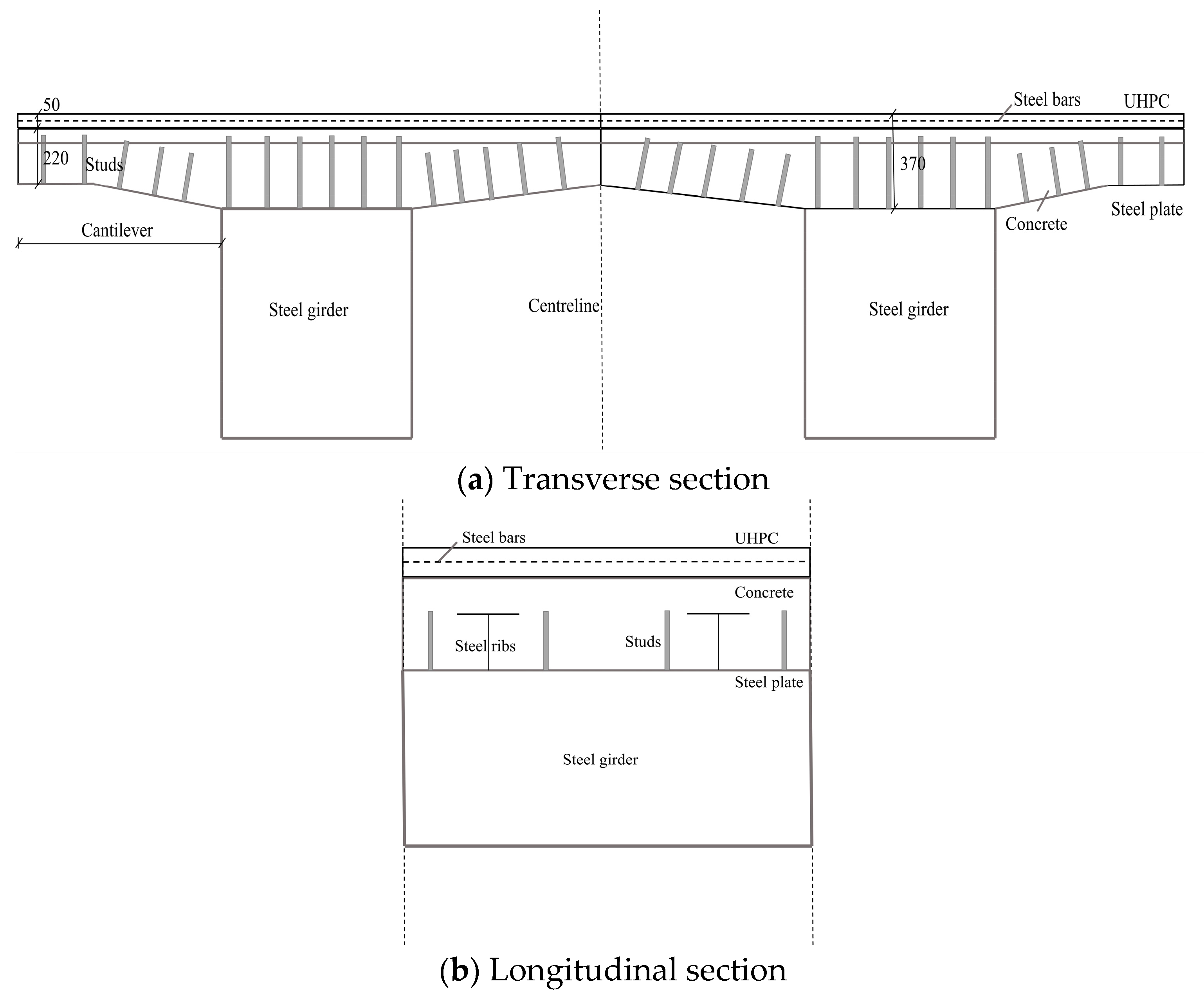


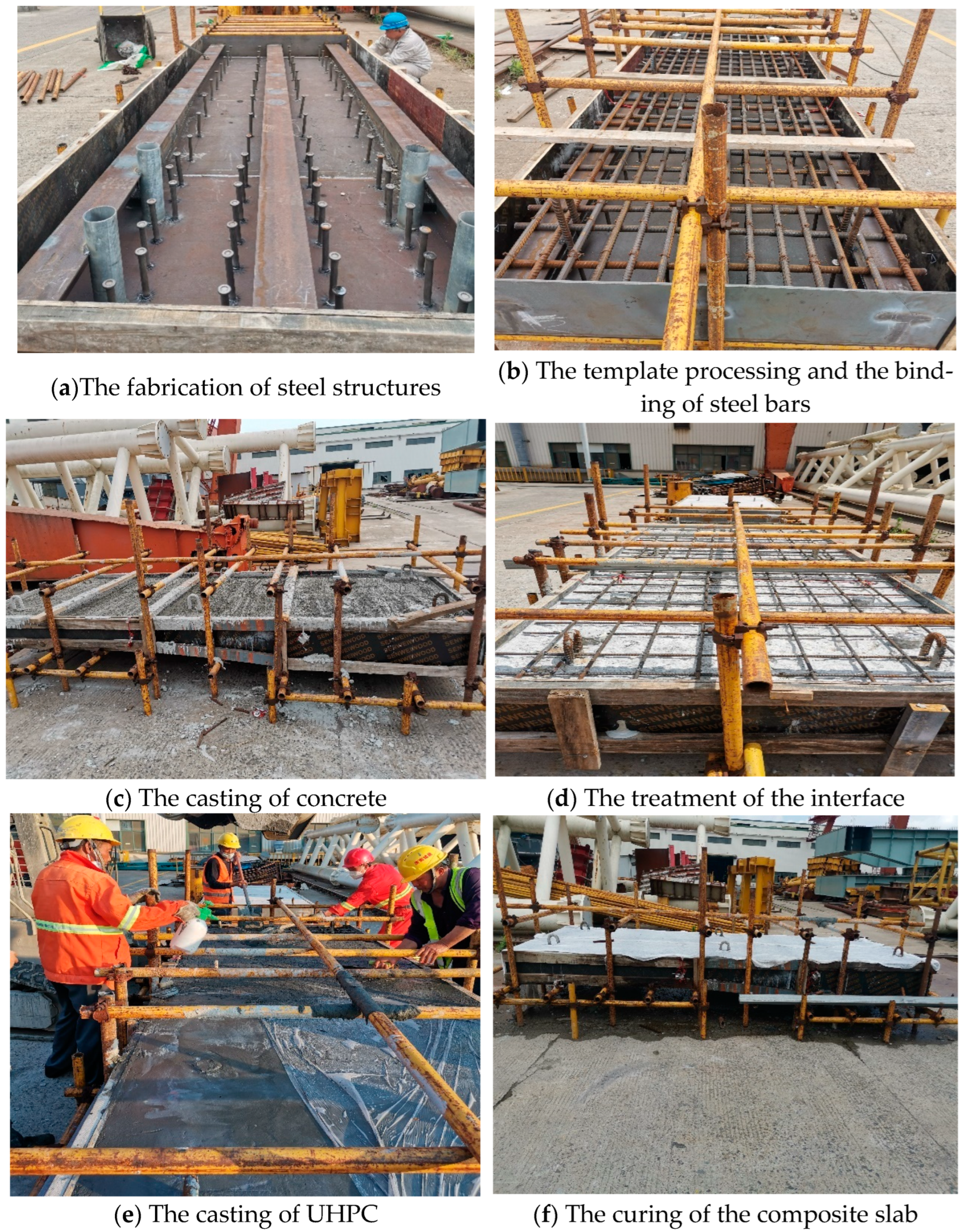

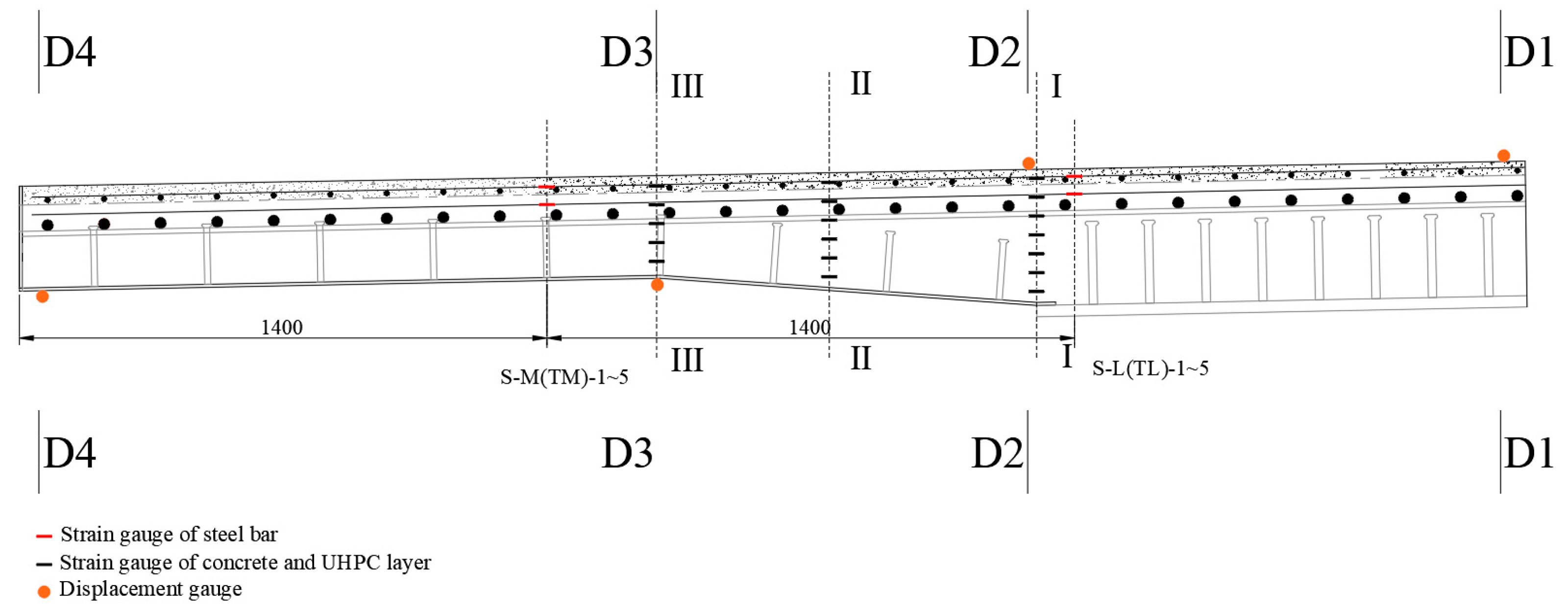
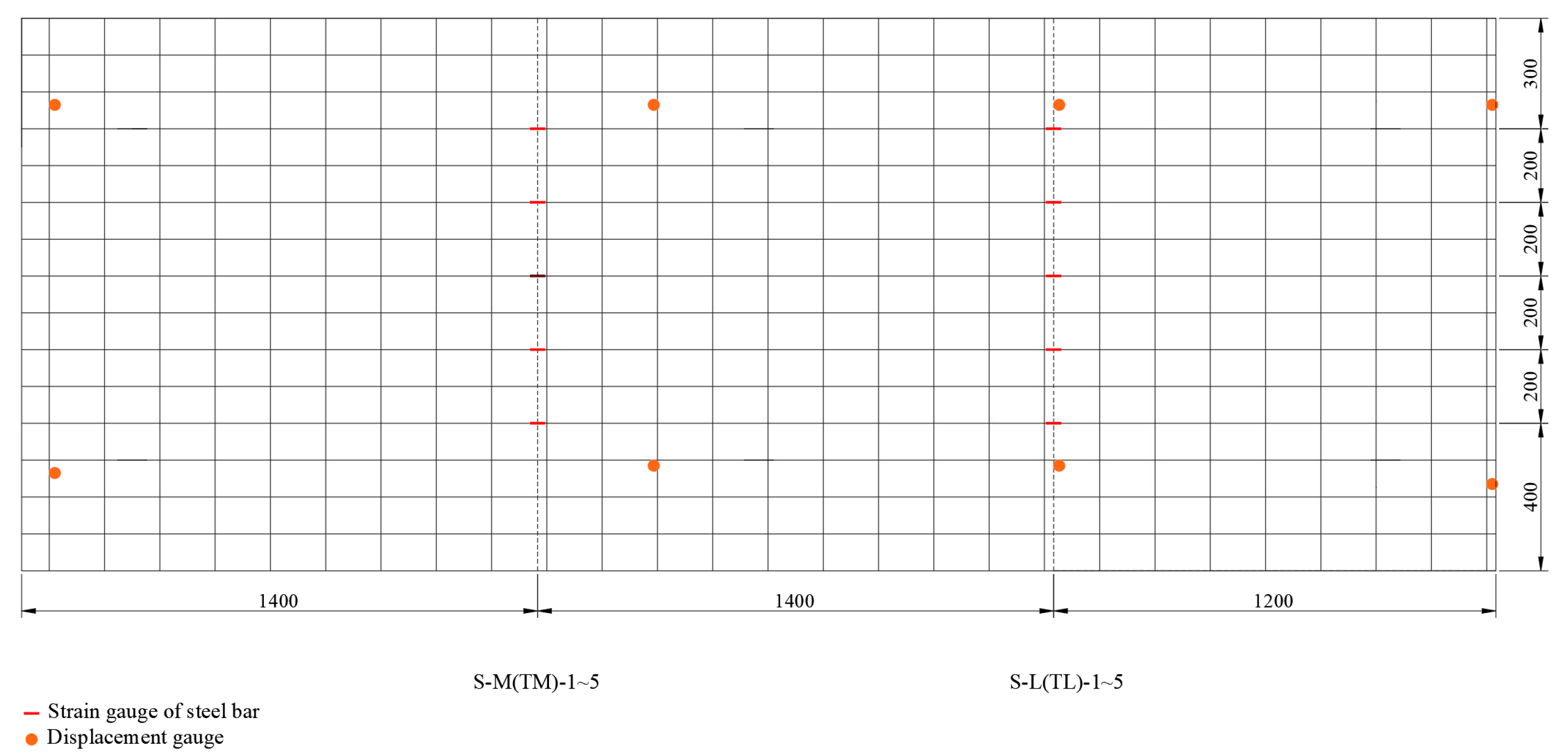
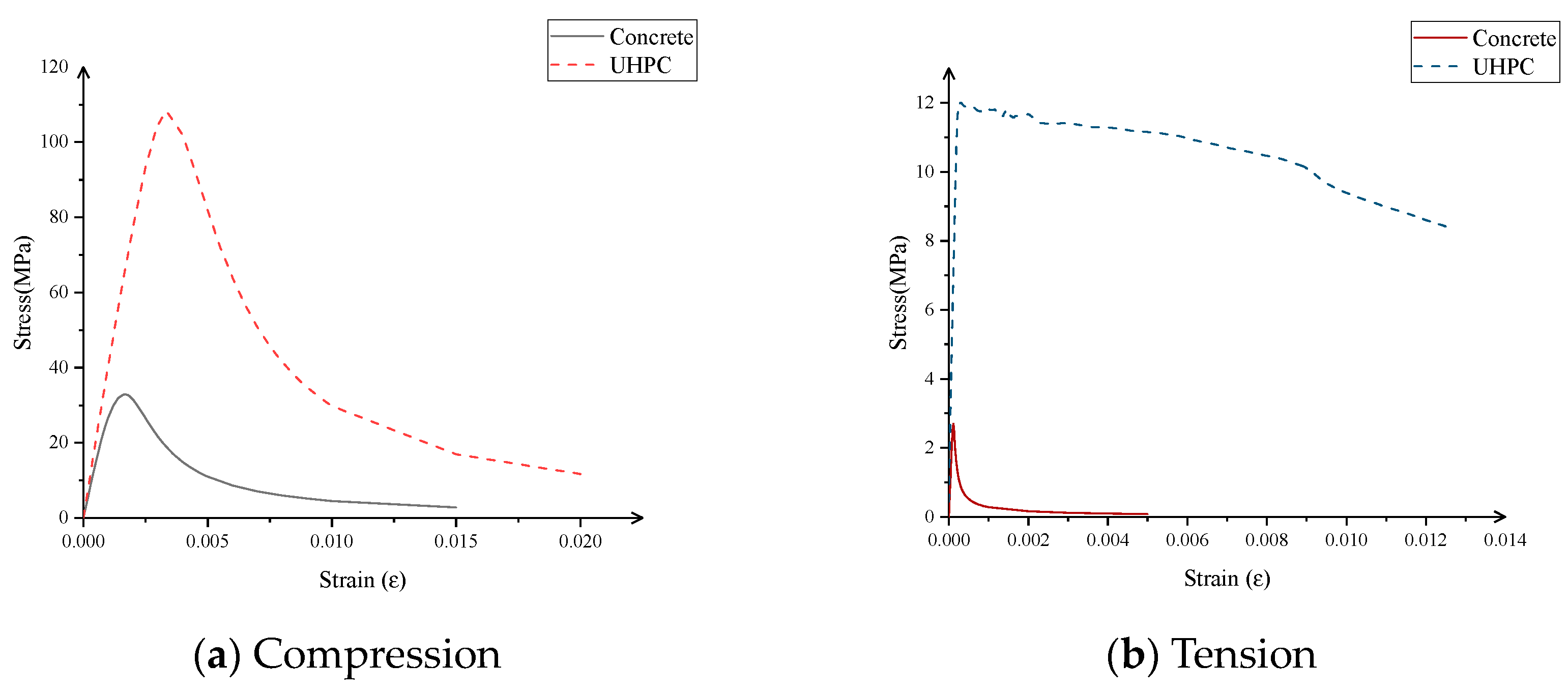
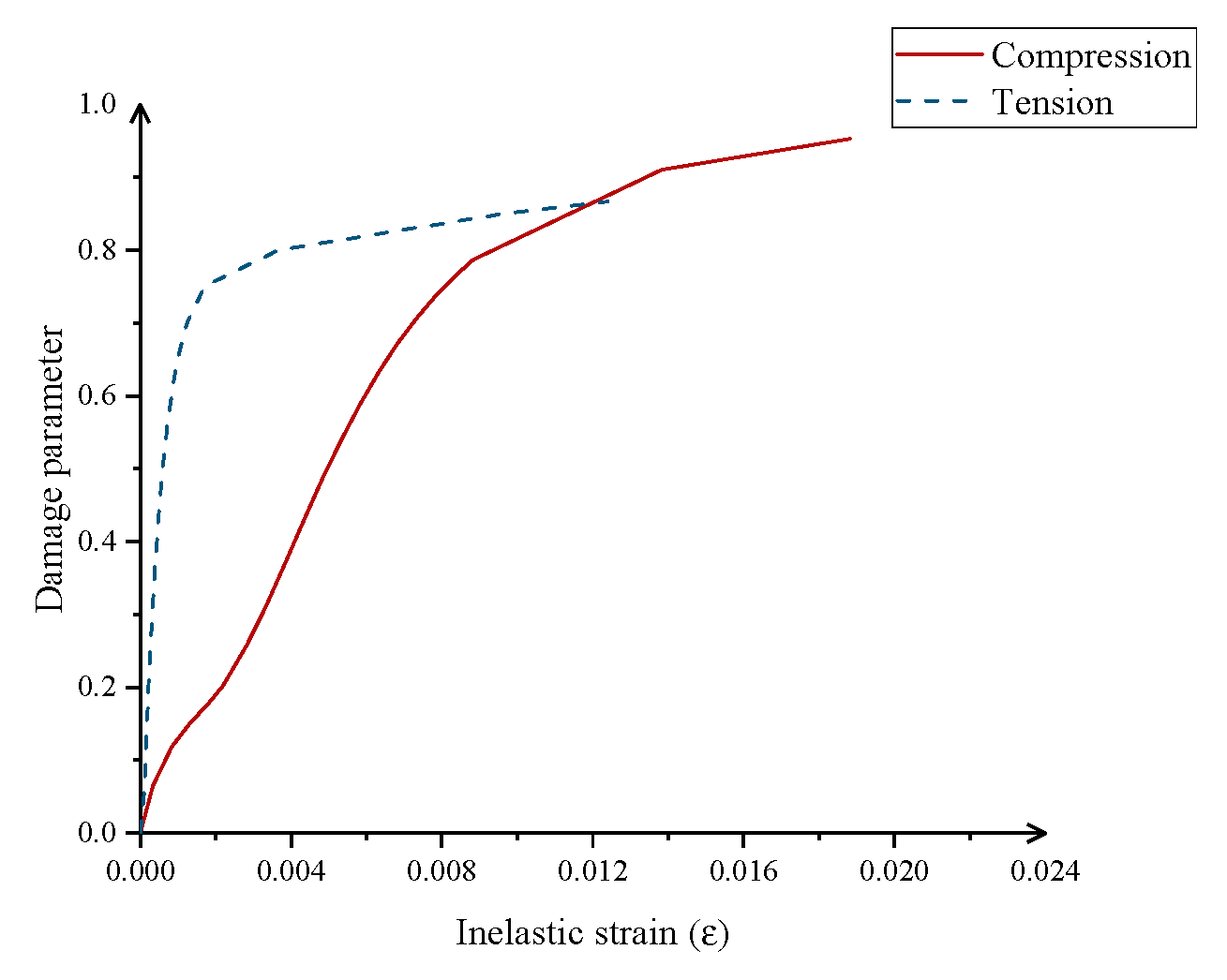
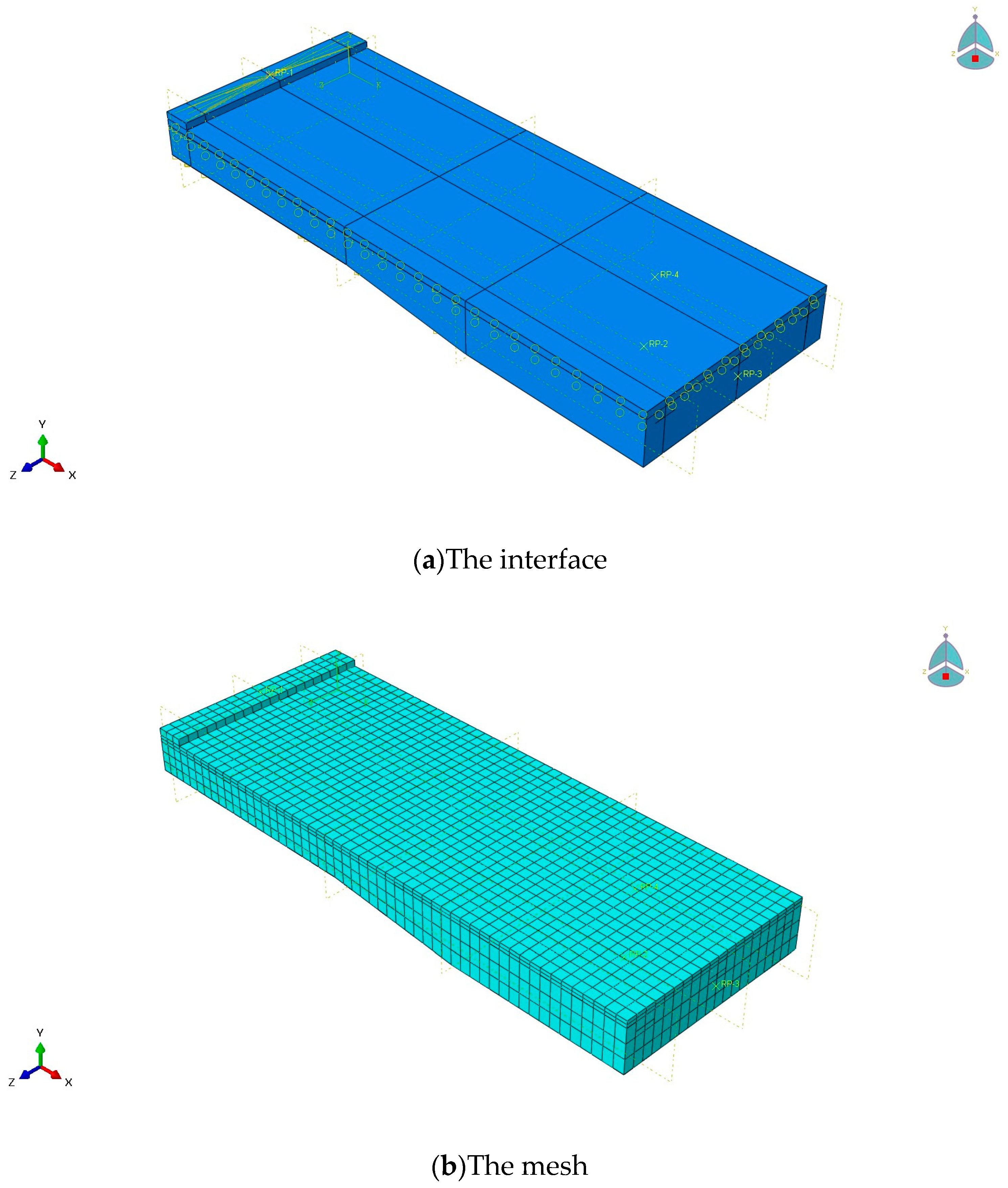



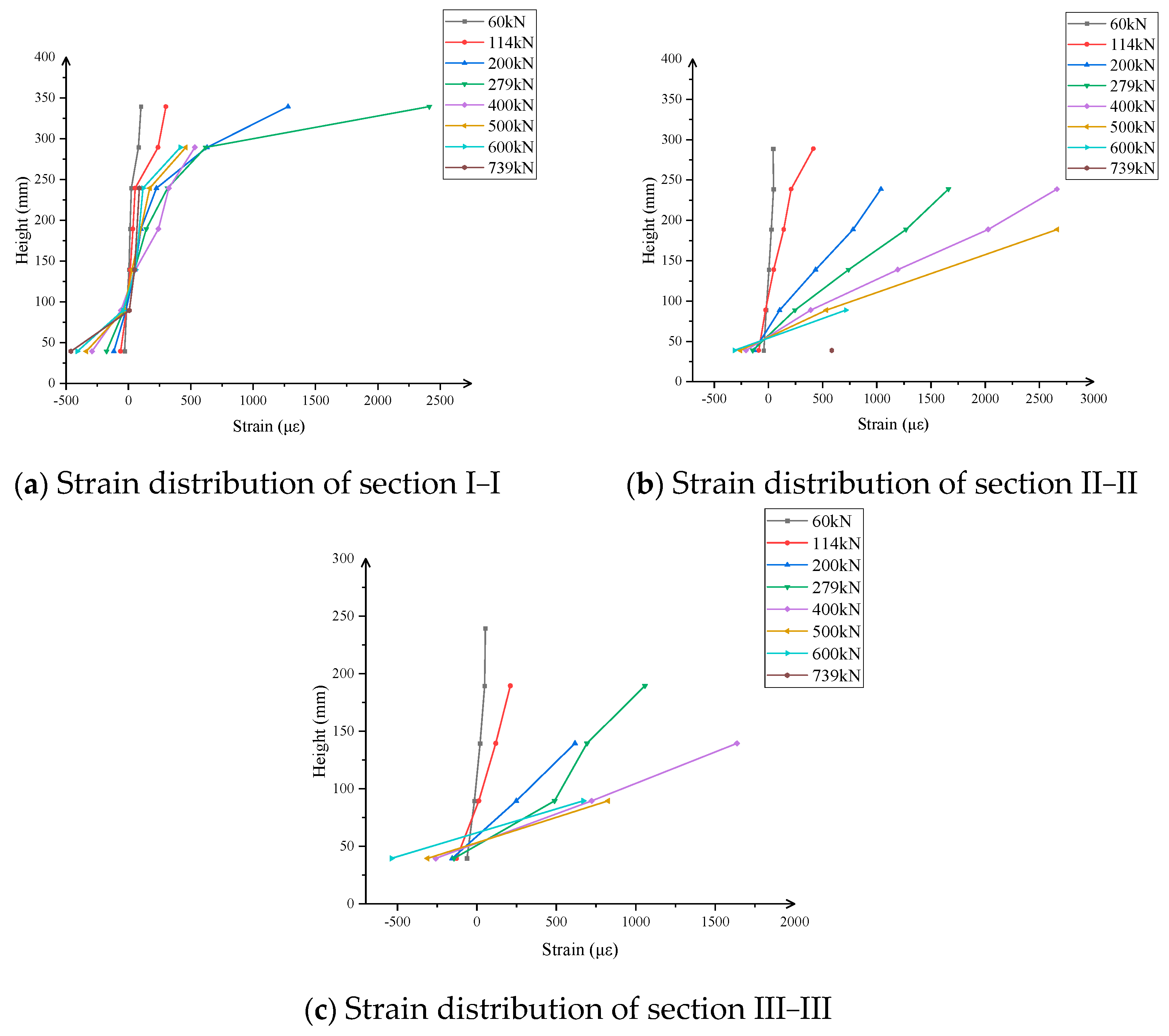
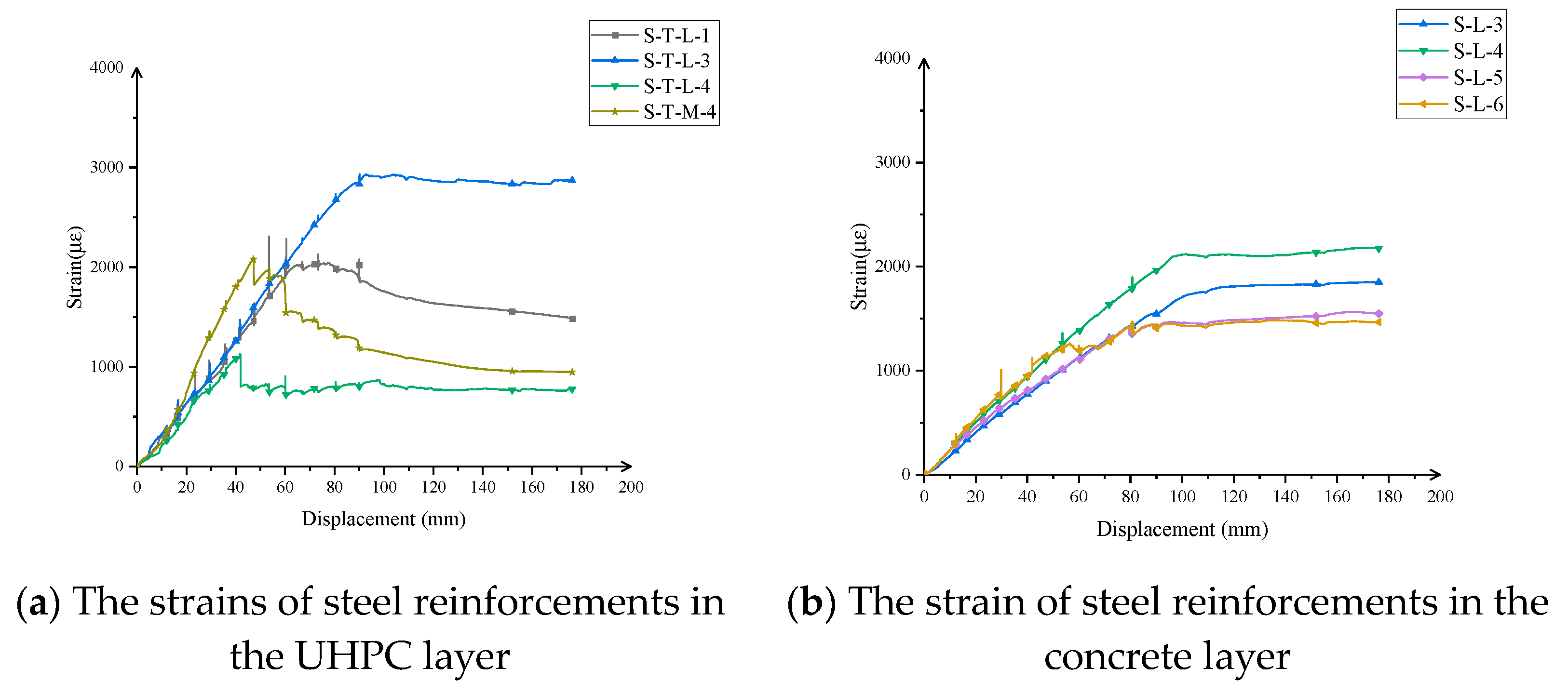



| Materials | Water (kg/m3) | Premix (kg/m3) | Steel Fibres (kg/m3) | Admixture (kg/m3) |
|---|---|---|---|---|
| UHPC/m3 | 177.30 | 2221.65 | 200.00 | 19.50 |
| Type | Diameter/Height (mm) | Yield Strength (MPa) | Tensile Strength (MPa) |
|---|---|---|---|
| Q355B | 8 | 383.0 | 532.0 |
| 20 | 435.0 | 580.0 | |
| HW350 | 350 | 389.0 | 557.8 |
| HRB400E | 25 | 447.5 | 617.5 |
| 12 | 437.5 | 597.5 | |
| ML15 | 16 × 180 | -- | 418.0 |
| 22 × 200 | -- | 465.0 |
| Construction Methods | Characteristics |
|---|---|
| Scaffolding construction | Initially, the self-weight of composite slabs is supported by the supports; before loading, composite slabs bear their own weight. Then, the UHPC layer and concrete are in a tensile state owing to their self-weight. |
| Construction without brackets | Firstly, the self-weight of the UHPC and concrete is supported by the bottom steel slabs; before loading, the UHPC layer and concrete are in a zero-stress state. |
| Specimens | Components | Construction Methods | Classification |
|---|---|---|---|
| A-1-Test | Steel–NC–UHPC composite slab | Scaffolding construction | Experimental specimens |
| A-1-FEM (self-weight) | Steel–NC–UHPC composite slab | Scaffolding construction | Finite element model |
| A-1-FEM | Steel–NC–UHPC composite slab | Construction without brackets | Finite element model |
| A-2-FEM | Steel–NC composite slab | Construction without brackets | Finite element model |
| A-2-FEM (self-weight) | Steel–NC composite slab | Scaffolding construction | Finite element model |
| Specimens | Cracking Load of Concrete (kN) | Cracking Load of UHPC (kN) | Ultimate Load (kN) | Error (%) |
|---|---|---|---|---|
| A-1-Test | 62 | 70 | 727 | -- |
| A-1-FEM (self-weight) | 69 | 117 | 683 | −5.96 |
| Specimens | Cracking Load of Concrete (kN) | Cracking Load of UHPC Layer (kN) | Ultimate Load (kN) | Increasing Ratio (%) |
|---|---|---|---|---|
| A-2-FEM | 44 | -- | 609 | -- |
| A-1-FEM | 91 | 133 | 691 | 13.51 |
| A-2-FEM (self-weight) | 29 | -- | 594 | -- |
| A-1-FEM (self-weight) | 69 | 117 | 683 | 15.10 |
| Specimens | Cracking Load of Concrete (kN) | Cracking Load of UHPC (kN) | Ultimate Bearing Capacity (kN) |
|---|---|---|---|
| A-1-Test | 62 | 70 | 727 |
| A-1-I | 56 | 93 | 658 |
Disclaimer/Publisher’s Note: The statements, opinions and data contained in all publications are solely those of the individual author(s) and contributor(s) and not of MDPI and/or the editor(s). MDPI and/or the editor(s) disclaim responsibility for any injury to people or property resulting from any ideas, methods, instructions or products referred to in the content. |
© 2024 by the authors. Licensee MDPI, Basel, Switzerland. This article is an open access article distributed under the terms and conditions of the Creative Commons Attribution (CC BY) license (https://creativecommons.org/licenses/by/4.0/).
Share and Cite
Guo, S.; Liu, C.; Ma, X. Flexural Performance of Steel–Normal Concrete–Ultra-High-Performance Concrete Composite Slabs with Steel Ribs. Buildings 2024, 14, 1301. https://doi.org/10.3390/buildings14051301
Guo S, Liu C, Ma X. Flexural Performance of Steel–Normal Concrete–Ultra-High-Performance Concrete Composite Slabs with Steel Ribs. Buildings. 2024; 14(5):1301. https://doi.org/10.3390/buildings14051301
Chicago/Turabian StyleGuo, Songsong, Chao Liu, and Xiaogang Ma. 2024. "Flexural Performance of Steel–Normal Concrete–Ultra-High-Performance Concrete Composite Slabs with Steel Ribs" Buildings 14, no. 5: 1301. https://doi.org/10.3390/buildings14051301
APA StyleGuo, S., Liu, C., & Ma, X. (2024). Flexural Performance of Steel–Normal Concrete–Ultra-High-Performance Concrete Composite Slabs with Steel Ribs. Buildings, 14(5), 1301. https://doi.org/10.3390/buildings14051301





